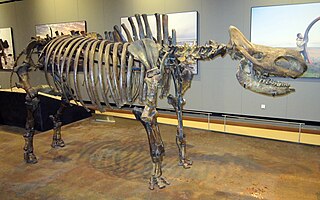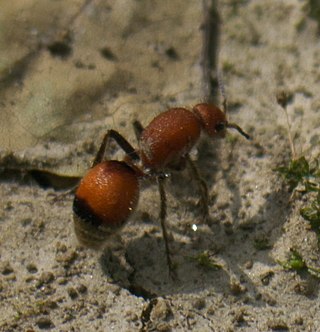Related Research Articles
In biology, taxonomy is the scientific study of naming, defining (circumscribing) and classifying groups of biological organisms based on shared characteristics. Organisms are grouped into taxa and these groups are given a taxonomic rank; groups of a given rank can be aggregated to form a more inclusive group of higher rank, thus creating a taxonomic hierarchy. The principal ranks in modern use are domain, kingdom, phylum, class, order, family, genus, and species. The Swedish botanist Carl Linnaeus is regarded as the founder of the current system of taxonomy, as he developed a ranked system known as Linnaean taxonomy for categorizing organisms and binomial nomenclature for naming organisms.

In biology, a taxon is a group of one or more populations of an organism or organisms seen by taxonomists to form a unit. Although neither is required, a taxon is usually known by a particular name and given a particular ranking, especially if and when it is accepted or becomes established. It is very common, however, for taxonomists to remain at odds over what belongs to a taxon and the criteria used for inclusion, especially in the context of rank-based ("Linnaean") nomenclature. If a taxon is given a formal scientific name, its use is then governed by one of the nomenclature codes specifying which scientific name is correct for a particular grouping.
The International Code of Phylogenetic Nomenclature, known as the PhyloCode for short, is a formal set of rules governing phylogenetic nomenclature. Its current version is specifically designed to regulate the naming of clades, leaving the governance of species names up to the rank-based nomenclature codes.

The wrentit is a small bird that lives in chaparral, oak woodlands, and bushland on the western coast of North America. It is the only species in the genus Chamaea.

A folk taxonomy is a vernacular naming system, as distinct from scientific taxonomy. Folk biological classification is the way people traditionally describe and organize the world around them, typically making generous use of form taxa such as "shrubs", "bugs", "ducks", "fish", "algae", "vegetables", or of economic criteria such as "game animals", "pack animals", "weeds" and other like terms.
Nomenclature codes or codes of nomenclature are the various rulebooks that govern biological taxonomic nomenclature, each in their own broad field of organisms. To an end-user who only deals with names of species, with some awareness that species are assignable to genera, families, and other taxa of higher ranks, it may not be noticeable that there is more than one code, but beyond this basic level these are rather different in the way they work.
Phylogenetic nomenclature is a method of nomenclature for taxa in biology that uses phylogenetic definitions for taxon names as explained below. This contrasts with the traditional approach, in which taxon names are defined by a type, which can be a specimen or a taxon of lower rank, and a description in words. Phylogenetic nomenclature is currently regulated by the International Code of Phylogenetic Nomenclature (PhyloCode).

Mesangiospermae is a clade of flowering plants (angiosperms), informally called "mesangiosperms". They are one of two main groups of angiosperms. It is a name created under the rules of the PhyloCode system of phylogenetic nomenclature. There are about 350,000 species of mesangiosperms. The mesangiosperms contain about 99.95% of the flowering plants, assuming that there are about 175 species not in this group and about 350,000 that are. While such a clade with a similar circumscription exists in the APG III system, it was not given a name.

Architaenioglossa is a taxonomic group of snails which have gills and often an operculum. They are primarily land and freshwater gastropod mollusks within the clade Caenogastropoda.
Clyomys is a South American rodent genus in the family Echimyidae. It contains two species, found in tropical savannas and grasslands from circa 100 m (300 ft) to 1,100 m (3,600 ft) elevation in central Brazil and eastern Paraguay.
Michel Laurin is a Canadian-born French vertebrate paleontologist whose specialities include the emergence of a land-based lifestyle among vertebrates, the evolution of body size and the origin and phylogeny of lissamphibians. He has also made important contributions to the literature on phylogenetic nomenclature.
The oesophageal pouches are a pair of pouches connected to the oesophagus of all molluscs, and represent a synapomorphy of the phylum.
Kirk J. Fitzhugh is the curator at the Natural History Museum of Los Angeles County, a position he has held since 1990. His research focuses on the systematics of polychaetes and on the philosophical foundations of evolutionary theory. Fitzhugh is a critic of DNA barcoding methods as a technical substitute for systematics. He attends Willi Hennig Society meetings where he has argued that "synapomorphy as evidence does not meet the scientific standard of independence...a particularly serious challenge to phylogenetic systematics, because it denies that the most severely tested and least disconfirmed cladogram can also maximize explanatory power." His graduate supervisor was V. A. Funk, from the U.S. National Herbarium, National Museum of Natural History, Smithsonian Institution MRC. He completed his doctoral thesis on Systematics and phylogeny of Sabellid polychaetes in 1988 while he was a research scientist at the LA County museum He married a lawyer named Nancy E. Gold in 1989.

The Erpobdelliformes are one of the currently-accepted suborders of the proboscisless leeches (Arhynchobdellida). It includes five families:

Caementodon is an extinct genus of rhinoceros of the clade Elasmotheriinae endemic to Europe and Asia during the Miocene.
Kevin de Queiroz is a vertebrate, evolutionary, and systematic biologist. He has worked in the phylogenetics and evolutionary biology of squamate reptiles, the development of a unified species concept and of a phylogenetic approach to biological nomenclature, and the philosophy of systematic biology.

Pompiloidea is a superfamily that includes spider wasps and velvet ants, among others, in the order Hymenoptera. There are 4 families in Pompiloidea.

Tiphioidea is a suggested superfamily of stinging wasps in the order Hymenoptera. There are three families in Tiphioidea, Bradynobaenidae, Tiphiidae, and Sierolomorphidae.
Strelkov's long-eared bat is a species of vesper bat found in mountainous regions of Central Asia.
Ward's long-eared bat is a species of vesper bat in the family Vespertilionidae. It is found in mountainous regions of South Asia and adjoining regions.
References
- ↑ Sharma, O. P. (2009). Plant Taxonomy 2E. Tata McGraw-Hill Education. p. 93. ISBN 9780070141599.
- ↑ Singh, Gurcharan (2009). Plant systematics: an integrated approach . Science Publishers. p. 40. ISBN 9781578086689.
- ↑ Laurin, M.; Cantino, P. D. (2004). "First International phylogenetic nomenclature meeting: a report". Zoologica Scripta. 33 (5): 475–479. doi:10.1111/j.0300-3256.2004.00176.x. S2CID 86552807.
- ↑ Laurin, M.; Cantino, P. D. (2007). "Second meeting of the International Society for Phylogenetic Nomenclature: a report". Zoologica Scripta. 36 (1): 109–117. doi:10.1111/j.1463-6409.2006.00268.x. S2CID 222198538.
- ↑ Laurin, M.; Bryant, H. N. (2009). "Third Meeting of the International Society for Phylogenetic Nomenclature: a Report". Zoologica Scripta. 38 (3): 333–337. doi:10.1111/j.1463-6409.2008.00379.x. S2CID 221171579.